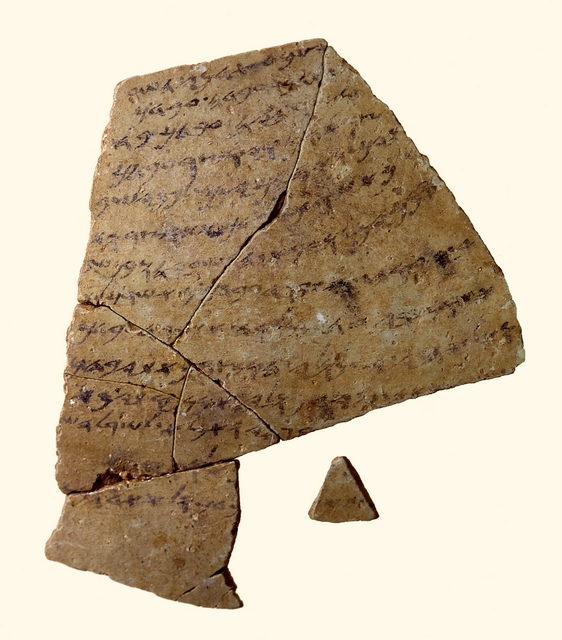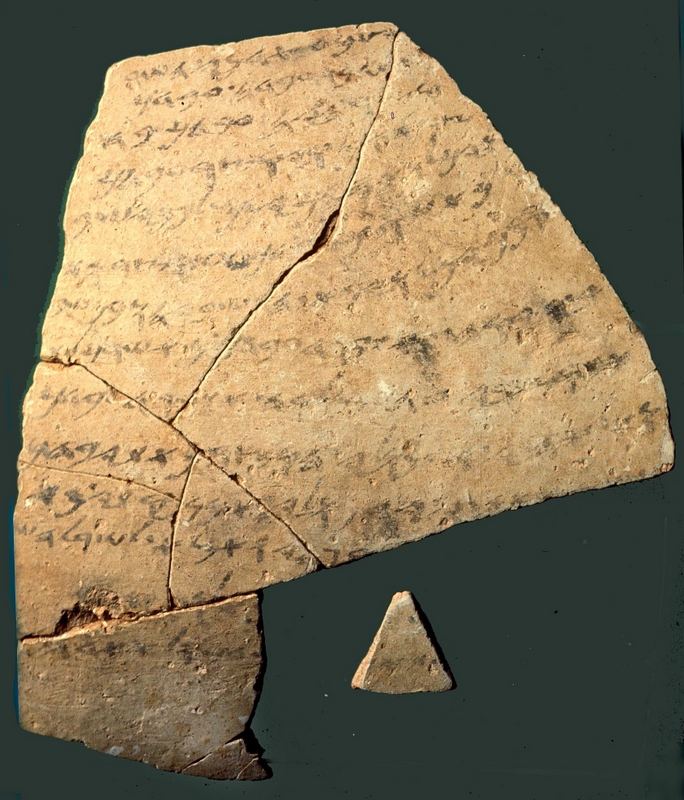Mezad Hashavyahu Ostracon, c. 630 BCE
A Worker Appeals for Justice- The First Example of Ethical-Monotheism
If you take your neighbor’s garment in pledge, you must return it to him before the sun sets; it is his only clothing, the sole covering for his skin. In what else shall he sleep? Therefore, if he cries out to Me, I will pay heed, for I am compassionate. (Exodus 22-25–26)
Date- 7th century BCE
Current Location- Israel Museum, Jerusalem, Israel
Language and Script- Biblical Hebrew; alphabetic
Biblical Verses- Exod. 22-25–26; Deut. 24-12–15, 17; Amos 2-8
General Information-
Located south of modern Tel Aviv-Yafo along the Mediterranean coast, the small Iron Age fortress known today as Mezad Hashavyahu was occupied for a relatively brief period during the latter half of the 7th century BCE. Archaeologists excavating the site in 1960 unearthed seven inscribed items, including six ostraca written in Hebrew. Ostraca are pottery sherds that were reused after the pot was broken as a writing surface. Written on one of these pieces is the appeal of a farm worker whose garment was confiscated by a supervisor as collateral on the grounds that the worker failed to meet his daily quota of grain and owed the rest. The worker claims that he did meet the quota and appeals to the local governor to expedite the return of his garment. Oddly, though it seems to be almost complete, the letter lacks a formula of address or signature from which we might learn the name of the governor or petitioner. Some scholars think that the worker dictated it to a scribe at the door of the governor’s office as an official record of the plea, leaving the names unnecessary. The ancient name of the site Mezad Hashavyahu remains unknown. Scholars named it as “the fortress of Hashavyahu” because the ostraca found there has the name Hashavyahu written on it.
Relevance to Ancient Israel- The contents of this ostracon have two potential Biblical connections.
• One is the question of the political relationship between the fortress where the ostraca were found and the Judean leadership in Jerusalem. Paleographically and archaeologically, the ostracon has been dated to the end of the 7th century BCE, which ought to be during the reign of King Josiah of Judah. Based on the language of the text and the presence of Yahwistic names in this ostracon (e.g., Hoshayahu) and the others from this site, it has been suggested that the site was under Judean control at the time. This is not certain, however, for there is another possible option- that the people there were Judean mercenaries working for Egypt. If the first option is correct, then the area under the control of the kingdom of Judah extended all the way to the Mediterranean coast and was much larger than previously thought.
• The other connection concerns the biblical prohibition against confiscating a poor person’s garment for payment of his debt, which is very similar to the situation presented in this ostracon. Even so, it does differ from the biblical scenario. The Bible only discusses confiscating a garment as collateral for a loan, whereas our worker is accused of not producing enough. And our worker objects by arguing that he has no debt to the owner since he met his quota rather than by appealing to the explicit biblical prohibition. This leaves us in a quandary since it seems that the biblical law was known based on its similarity to the plea, but the Law was not invoked explicitly even by the scribe, who probably would have had knowledge of the Bible. It seems to hint to some instability in the biblical text (probably still oral at that time) or to its dissemination, unless there is just a local reason that a stronger connection to the biblical verse wasn’t made.
Circumstances of Discovery and Acquisition- See above.
See also-
The First Extra-Biblical Reference to the Sabbath, c. 630 BCE





